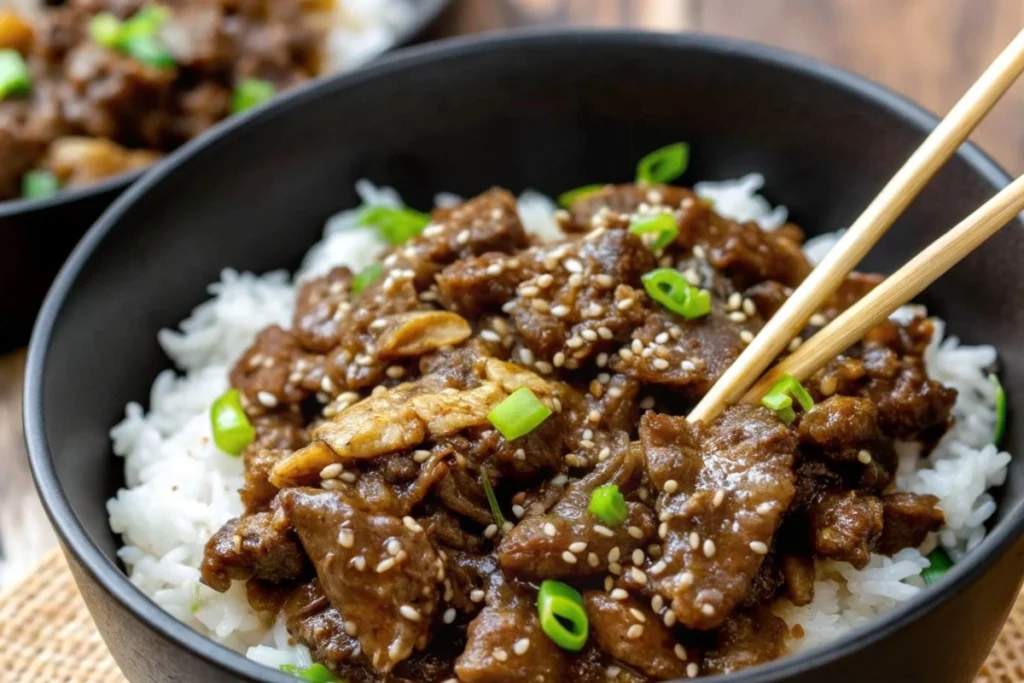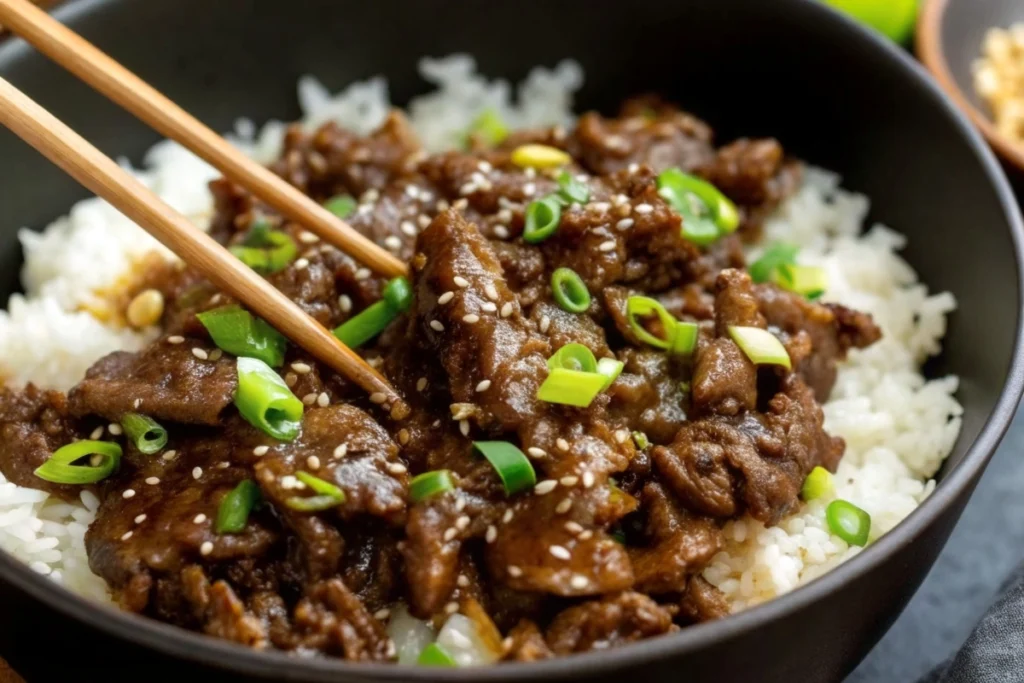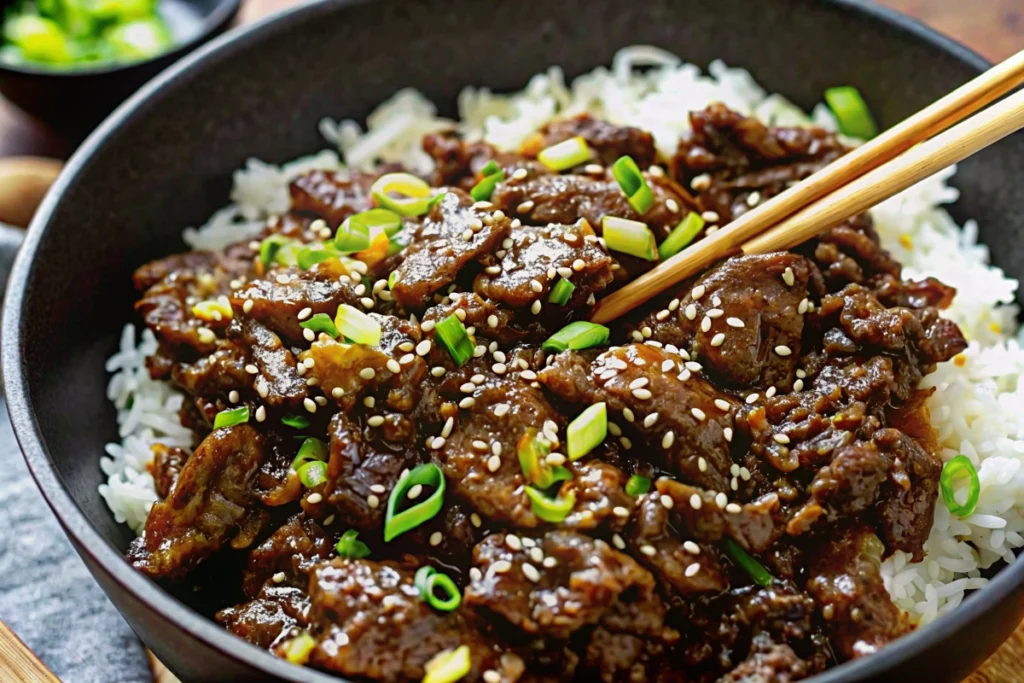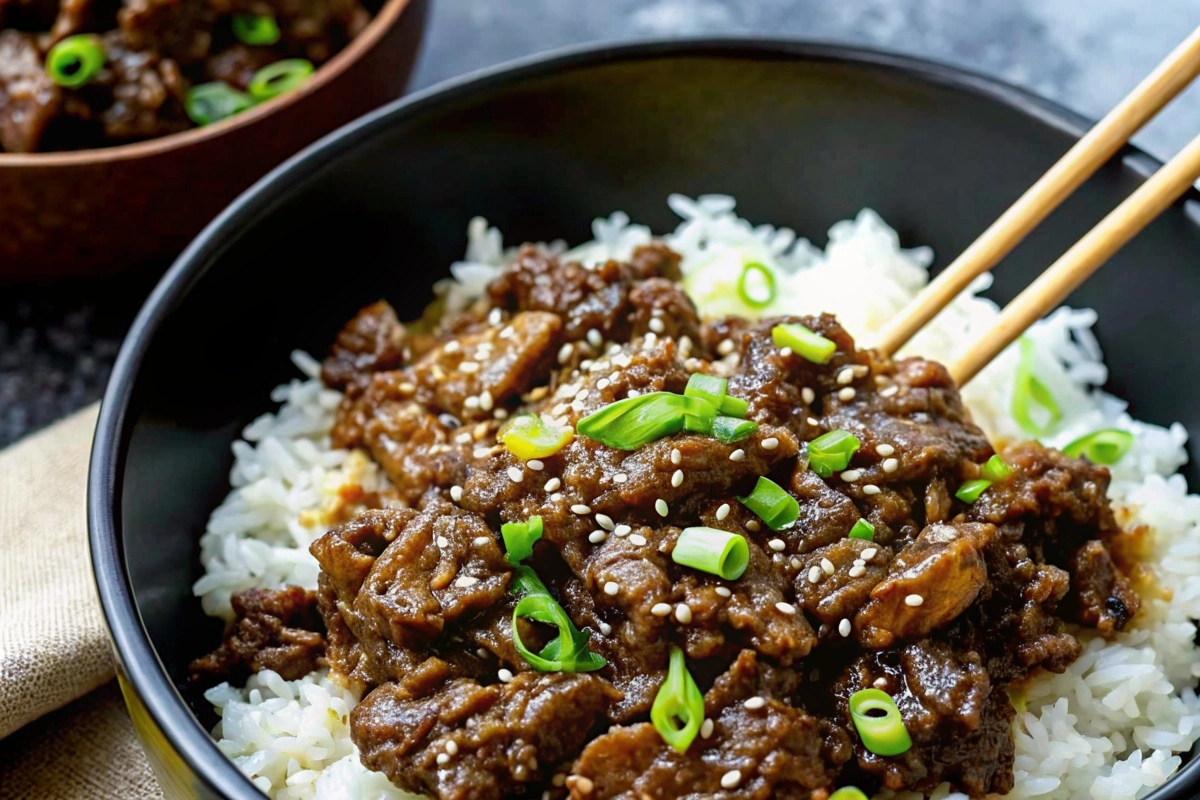Classic Mongolian Beef: A Timeless Culinary Masterpiece
Historical and Cultural Roots
The history of Classic Mongolian Beef is as intriguing as its robust flavor profile. Despite its name, the dish is not a traditional recipe from Mongolia. Instead, it emerged from the inventive kitchens of American-Chinese restaurants, drawing upon inspirations from various Asian culinary traditions.
- The dish’s modern evolution intertwines traditional ingredients with contemporary techniques.
- Many enthusiasts often debate whether the origin is truly Mongolian or simply an homage to the bold flavors reminiscent of the region.
- Its popularity soared in the late 20th century as American diners embraced the quick, flavorful preparation typical of stir-fry recipes.
The creation of Classic Mongolian Beef stands as a testament to the ingenuity of chefs who adapted traditional Asian flavors for the North American market. This adaptation was guided by a desire to bring intense flavors, rapid preparation times, and visually appealing dishes to family dinner tables and upscale restaurants alike. In a similar vein, you can also refer to the Beef Lo Mein Recipe to learn more about selecting the best cuts of beef for such recipes and understanding optimal cooking methods.
Essential Ingredients: The Building Blocks of Flavor
Creating the perfect Classic Mongolian Beef begins with the careful selection and preparation of each ingredient. The magic of the dish is found in its delicate balance between the tenderness of the beef and the captivating, caramelized glaze that coats it.
Key Components
- Beef:
- Use quality beef cuts like flank or sirloin for the best texture.
- Cut the beef thinly against the grain to maintain tenderness and facilitate even cooking.
- Marinade and Sauce Ingredients:
- Soy sauce serves as the salty, umami base.
- Brown sugar lends a natural sweetness that caramelizes beautifully in the pan.
- A blend of garlic and ginger infuses the dish with aromatic depth, while a touch of hoisin sauce adds a layer of complexity.
- Scallions and optional hints of chili can be added for both flavor contrast and appealing presentation.
- Additional Elements:
- A good stir-fry requires a high smoke-point oil such as vegetable or peanut oil, ensuring rapid cooking with minimal stickiness.
- Complementary garnishes such as sliced scallions or a drizzle of extra sauce can elevate both the taste and presentation.
Each ingredient in this dish plays an indispensable role in creating its signature taste. The interplay between savory and sweet, along with the aromatic backdrop provided by garlic and ginger, results in a harmonious flavor profile that is both complex and irresistibly appealing.
The Art of Ingredient Preparation
Before starting the cooking process, take the time to prepare and arrange your ingredients to ensure smooth execution. Here are a few key preparation tips:
- Beef Slicing and Marinating:
- Slice the beef thinly and uniformly.
- Marinate the beef for about 15 to 30 minutes in a mixture of soy sauce, brown sugar, and a pinch of salt to enhance flavor without overpowering it.
- Sauce Assembly:
- Combine soy sauce, brown sugar, garlic, ginger, and a splash of water in a bowl.
- Stir well until the sugar is thoroughly dissolved, ensuring a smooth, balanced sauce that will coat each piece of beef evenly.
- Vegetable Preparation:
- Wash and chop scallions for garnish.
- If adding extra vegetables like bell peppers or onions, slice them thinly to maintain a consistent texture throughout the stir-fry.

Preparing these components meticulously ensures that once the heat is on, each element contributes its maximum potential to the final dish, creating an authentic and irresistible Asian stir-fry experience.
Mastering the Marinade and Stir-Fry Technique
Achieving the perfect texture and flavor in Classic Mongolian Beef hinges on the precision of both the marinade and the stir-fry technique. Detailed below are the steps and tips to help you master each process with excellence.
Marinade Essentials
- Mixing the Perfect Marinade:
- In a large bowl, blend soy sauce, brown sugar, minced garlic, and fresh ginger.
- Ensure that every ingredient is well-mixed to create a consistent marinade that will coat your beef evenly.
- Marination Time and Tips:
- Let the beef sit in this marinade for at least 15 to 30 minutes before cooking.
- Do not over-marinate; excessive time can sometimes break down the meat fibers too much, compromising the texture.
- For added depth, consider lightly dusting the beef with a small amount of cornstarch before marinating. This step creates a slight coating that will help the sauce cling to the meat during cooking.
Stir-Fry Technique: A Quick-Fire Approach
The heart of Classic Mongolian Beef lies in its rapid stir-fry technique, which captures the essence of high-heat, quick-cooking methods used in traditional wok cooking. Here’s how to perfect it:
- Preheating the Wok:
- Use a heavy-bottomed wok or a wide skillet, and preheat it over high heat. This ensures that the pan is hot enough to sear the beef instantly.
- Oil Selection and Usage:
- Choose an oil with a high smoke point, such as vegetable or peanut oil.
- Add enough oil to lightly coat the bottom of the pan, but avoid excessive amounts that could lead to greasy results.
- Cooking in Batches:
- Avoid overcrowding the pan by cooking the beef in small batches.
- This practice helps in achieving a beautiful sear on each piece, preserving its tenderness inside while imparting a rich, caramelized exterior.
- Monitoring Heat:
- Keep the heat consistently high during the cooking process to ensure that the beef cooks quickly and evenly.
- Stir frequently to prevent sticking and achieve an even, crispy finish on the edges of the beef slices.
- Creating the Signature Sauce:
- Once the beef is seared to perfection, remove it temporarily from the wok.
- Pour the prepared sauce into the pan and allow it to simmer briefly until it starts to thicken and glaze the surface.
- Return the beef to the pan, ensuring every piece is well-coated with the sumptuous sauce.
By following these steps, you unlock the secret to a perfectly balanced dish where each slice of beef carries a delightful mix of flavors and a pleasing texture that defines Classic Mongolian Beef.
The Detailed Cooking Process: From Start to Finish
With the ingredients prepped and techniques understood, it’s time to bring everything together. The following step-by-step guide will walk you through creating a mouth-watering dish that truly stands out.
Step-by-Step Cooking Instructions
- Preheat and Prepare:
- Heat your wok or large skillet over high heat.
- While the pan is heating up, ensure that your beef is sliced thinly and evenly.
- Have your marinade and sauce ingredients pre-mixed and within reach.
- Marinate the Beef:
- Place the beef in the bowl with the marinade.
- Let it sit for 15 to 30 minutes. This period allows the flavors to infuse into the meat without compromising its structure.
- Searing the Beef:
- Add the high smoke-point oil to the preheated pan.
- Working in small batches, sear the beef for about 1-2 minutes on each side until a light crust forms.
- Remove the beef from the pan once seared and set aside temporarily.
- Developing the Sauce:
- Lower the heat slightly and add the pre-mixed sauce directly into the same pan.
- Let the sauce simmer, stirring continuously, until it reaches a slightly thickened consistency that will cling to the beef.
- Reuniting the Ingredients:
- Once the sauce has thickened, return the seared beef to the pan.
- Toss the beef gently in the sauce until every piece is thoroughly coated.
- Introduce fresh scallions and, if desired, a hint of chili for an extra kick.
- Final Sealing and Plating:
- Give the beef one last quick toss in the pan to allow the flavors to meld completely.
- Plate immediately while hot to preserve the dish’s enticing aromas and textures.
- Garnish generously with additional chopped scallions for a pop of color and freshness.
Bullet Points of Key Cooking Reminders
- Preheat your pan thoroughly to ensure a quick, high-heat sear.
- Marinate the beef for the perfect balance of flavor without overdoing it.
- Cook in small batches to avoid overcrowding the pan.
- Stir consistently during sauce development to achieve the ideal caramelized consistency.
- Garnish with chopped scallions to add a fresh, vibrant finish.

Following these detailed steps will not only ensure a dish that is bursting with flavor but will also help you maintain control over the cooking process, allowing each element of the recipe to shine through.
Exploring Creative Variations
While the traditional Classic Mongolian Beef recipe delivers an unforgettable taste experience, exploring subtle variations can elevate the dish even further. Experiment with different ingredients and techniques to discover what best suits your taste preferences.
Variations to Consider
- Spice Adjustments:
- Add a kick: Introduce chili flakes or finely chopped fresh chili peppers during the sauce simmering stage for those who enjoy a spicier profile.
- Milder version: Keep the heat minimal if you prefer the signature sweet-savory balance of the dish.
- Enhanced Aromatics:
- Experiment with additional aromatics such as finely chopped scallions mixed into the sauce.
- For an extra burst of flavor, a small amount of sesame oil may be added towards the end of cooking for a fragrant finish.
- Alternative Cuts of Beef:
- While flank or sirloin are traditional choices, some cooks experiment with alternative cuts that still maintain a tender texture when sliced thinly.
- The key is to choose beef that can sear quickly without sacrificing tenderness.
- Fusion Twists:
- Incorporate elements from other cuisines, such as a dash of rice vinegar or a sprinkle of toasted sesame seeds, to add a new dimension to the classic recipe.
- While staying true to the original spirit of the dish, these creative adjustments can offer a delightful twist that surprises and delights your guests.
- Vegetarian Alternatives:
- For those looking to enjoy a similar flavor profile without beef, tofu or seitan can be used as a substitute.
- Marinate and cook these alternatives similarly to the traditional method to allow the sauce to impart its characteristic flavor effectively.
Tips for Customizing Your Dish
- Experiment Gradually:
- Introduce one variation at a time to assess its impact on the overall flavor balance.
- Maintain detailed notes on each variation’s outcome to refine your recipe over multiple trials.
- Share and Compare:
- Engage with fellow food enthusiasts, discuss your experimental recipes, and exchange tips.
- Social media platforms and cooking communities are excellent venues for sharing your unique take on Classic Mongolian Beef.
- Keep the Fundamentals Intact:
- Remember that the core of the dish—its stir-fry technique and signature sauce—should always remain recognizable, even when trying new twists.
By exploring these creative variations, you can transform Classic Mongolian Beef from a familiar comfort food into a personalized culinary masterpiece that continually delights and surprises.

Answering the Most Common Questions
Even the most seasoned cooks can have questions when it comes to preparing Classic Mongolian Beef. Here are some frequently asked questions that address common uncertainties and offer actionable advice.
Frequently Asked Questions
- What exactly is Classic Mongolian Beef?
Classic Mongolian Beef is a dish characterized by its thinly sliced beef, seared quickly in a hot pan, and coated in a rich, sweet-savory sauce. While its name hints at Mongolian origins, the dish is a product of culinary innovation from American-Chinese restaurants. - Which cuts of beef work best for this dish?
For the optimal texture and flavor, beef cuts like flank or sirloin are recommended. These cuts provide a tender yet chewy bite when sliced thinly and cooked quickly. - How can I achieve the ideal sauce consistency?
The key is to simmer the sauce until it thickens just enough to coat the beef without becoming overly dense. Stir constantly to prevent sticking and ensure that the sauce glazes each piece evenly. - Is it possible to prepare the dish ahead of time?
Classic Mongolian Beef is best enjoyed fresh, as the rapid cooking process helps maintain the crisp texture of the beef. However, leftovers may be stored in an airtight container and gently reheated on the stove, ensuring not to overcook the meat. - What are some common mistakes to avoid?
- Overcrowding the Pan: This can result in steaming rather than searing the beef.
- Over-marinating: Too much time in the marinade can break down the beef fibers excessively.
- Excessive Saucing: Avoid an overly thick sauce that may mask the natural flavor of the beef.
- Are there any regional variations of Classic Mongolian Beef?
While the fundamentals remain the same across most versions, slight variations can be found across different restaurants and home kitchens, allowing cooks to tweak and personalize the dish to their taste.
Bringing It All Together: The Final Steps
As you reach the final stages of preparing Classic Mongolian Beef, remember that every step—from selection and preparation of ingredients to the precise execution of the stir-fry technique—plays an integral role in the overall success of the dish.
Final Assembly and Presentation
- Rehearse the Process:
- Follow each step carefully, ensuring the beef is seared quickly and efficiently.
- Allow the sauce to develop its perfect consistency before reintroducing the meat for a final coating.
- Presentation Is Key:
- Plate your dish immediately after cooking to retain its fresh aroma and textures.
- Garnish generously with freshly chopped scallions, and consider a few extra sprinkles of a finishing ingredient to add visual appeal.
- Tips for a Stellar Final Touch:
- Serve the beef with complementary sides like steamed white rice or lightly sautéed vegetables for an immersive dining experience.
- Document your process and share your results. Your evolving recipe can lead to a truly unique version that both friends and family will admire.
A Journey Beyond the Recipe
Classic Mongolian Beef is more than just a dish—it is a journey through culinary innovation and cross-cultural exchange. From its humble origins as a restaurant favorite to its current status as an at-home staple, the dish embodies the spirit of creativity and adaptability in the kitchen.
Reflecting on Tradition and Innovation
- The evolution of Classic Mongolian Beef reflects how traditional techniques can be merged with modern methods to create a dish that appeals to contemporary tastes.
- The simplicity of the ingredients, when combined with the precision of wok cooking, forms a culinary masterpiece that is both bold and delicious.
- The dish is a celebration of flavor—a true masterpiece that balances the savory, sweet, and umami in a way that captivates the taste buds with every bite.
Embracing Your Culinary Creativity
- Experiment Freely:
- Make small adjustments to the marinade or sauce to find your preferred balance.
- Don’t be afraid to add your twist—this is your opportunity to craft a dish that not only honors tradition but also reflects your style.
- Learn and Grow:
- Each time you prepare Classic Mongolian Beef, take note of any modifications that improve the flavor or texture.
- Over time, you’ll develop techniques that ensure every attempt is better than the last, creating an evolving signature dish that is uniquely yours.
- Share the Joy:
- Invite friends and family to experience your version of this classic dish.
- Use their feedback as inspiration for further refinement. Celebrating culinary creativity is as important as mastering the recipe itself.
Final Thoughts and Encouragement
The art of preparing Classic Mongolian Beef is a testament to the power of flavor and tradition. By understanding the cultural roots, meticulously preparing the essential ingredients, mastering the marinade and stir-fry technique, and exploring creative variations, you can elevate a simple recipe to a culinary art form.
- Celebrate the heritage of the dish by embracing both its traditional elements and the room for innovation it offers.
- Enjoy the process: Each step in the cooking journey contributes to the final masterpiece—a dish that is as much about the experience as it is about the taste.
- Share your passion: Whether you’re serving it at a family dinner or a small gathering, let your creation ignite conversations and spark joy.
As you set out to recreate this timeless recipe, remember that every cook’s touch is unique. The beauty of Classic Mongolian Beef lies in its versatility and adaptability, allowing you to make it your own while staying true to its origins. Enjoy the vibrant process of cooking and the delightful rewards that follow.
In Conclusion
Classic Mongolian Beef is a culinary delight that brings together the best elements of Asian stir-fry cuisine and modern cooking techniques. From its intriguing history and carefully selected ingredients to the precision of its preparation and vibrant presentation, every aspect of this dish is designed to captivate both the eyes and the taste buds.


4 thoughts on “7 Steps to Make Classic Mongolian Beef: Authentic & Flavorful Recipe”